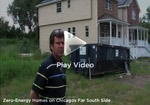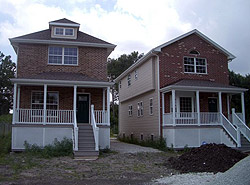Get a walk-though of this home.
On what was once a weedy parcel of land in Veterans Park—situated on Chicago’s South Side near where the Skyway crosses above 95th Street—Bernie Schmidt has built the first of what he hopes will be 20 midsize homes that use no electricity from the utility grid. If completed on the linear plot of land adjacent to rows of tidy bungalows, the subdivision, called Solar Verde Estates, will be the city’s first zero-energy block.
|
|
These homes, which look like trim descendants of the standard farmhouse style, collect solar energy via their "solar shingles," small solar panels laid across most of the south-facing sections of the roof. What’s more, the houses will hold on to heated and cooled air well, because they are built super-tight with a wall system that amounts to steel frames holding hefty blocks of insulating Styrofoam (all of which is concealed behind conventional wallboard). They also rely on such simple old-fashioned energy-saving devices as ceiling fans, which can help cool some rooms without the use of air conditioning.
"We’re going for zero net energy here," Schmidt says of his nascent subdivision in the 9500 and 9600 blocks of South Marquette Avenue. "You make all your own energy on the roof, and what you don’t need, you’ll feed back to Com Ed to prepay for any electricity you can use later." (Commonwealth Edison "pays" people who contribute energy into the grid with credits toward their electricity bills, not with cash. Homeowners can’t make a profit; they can only run their own bills down to zero.)
Schmidt had spent the past two decades building upscale homes in the North Shore suburbs. His decision to take his current project to a more moderately priced neighborhood was strategic. "People who can afford luxuries are asking for the new ‘green’ thing," he says, while less-affluent homeowners appreciate "the things that are going save them a lot of money over time, like energy conservation and alternate energy."
Each of the project’s two model homes "has been making $75 to $100 worth of electricity a month," Schmidt says. "We’re not paying for any of these lights," he says, flipping a switch to illuminate one of the home’s basements. Along with their energy-saving amenities, the houses also have sustainable finishes, including bamboo floors, paints that emit no volatile organic compounds (VOCs), and kitchen counters manufactured from recycled plastic.
When planning the homes with the architecture firm A Design Consultants of Naperville, Schmidt focused on using building materials and energy-gathering systems that can be installed by conventional trades people with little or no additional training or equipment. While helping to keep costs down, that strategy also demonstrated that these methods could be used in Chicago in ordinary homes. Specialty materials and laborers would add 15 to 20 percent to the cost of construction, Schmidt says, while using easily adapted methods and materials kept the premium to down around 5 percent above typical costs.
Even so, the houses at Solar Verde Estates, which start at $339,000, come in well above the prevailing prices in the neighborhood. According to records at Midwest Real Estate Data, recent nearby sales are most often between $150,000 and $160,000 (only once in two years have they surpassed $200,000). Those houses are half the price of the Solar Verde residences, but they are also smaller—about 1,100 square feet—and older, and often come with dated energy-hog furnaces, air conditioners, and appliances.
Schmidt is confident that he has a product that will attract two types of buyers: those who want to help the environment, and residents of the neighborhood who want to move up to a nicer house but haven’t had many options until now. "Chicago is a very green city," Schmidt says. "There is a lot of momentum behind the green development. You see people out looking for something like this."
For information on the development, go to www.solarverde.com or call Coldwell Banker agent Sandra Guthrie, 847-337-4252.
 On what was once a weedy parcel of land in Veterans Park—situated on Chicago's South Side near where the Skyway crosses above 95th Street—Bernie Schmidt has built the first of what he hopes will be 20 midsize homes that use no electricity from the utility grid. If completed on the linear plot of land adjacent to rows of tidy bungalows, the subdivision, called Solar Verde Estates, will be the city's first zero-energy block..." />
On what was once a weedy parcel of land in Veterans Park—situated on Chicago's South Side near where the Skyway crosses above 95th Street—Bernie Schmidt has built the first of what he hopes will be 20 midsize homes that use no electricity from the utility grid. If completed on the linear plot of land adjacent to rows of tidy bungalows, the subdivision, called Solar Verde Estates, will be the city's first zero-energy block..." />




